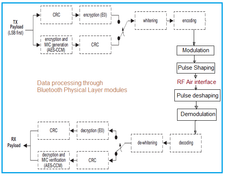Z-Wave Physical Layer (PHY) Basics
Advertisement
This page covers the fundamental aspects of the Z-Wave physical layer (PHY) and includes a Z-Wave PHY transmitter block diagram. The Z-Wave physical layer is responsible for the following key functions:
- Assigning RF profiles to the Z-Wave physical channel.
- Activating and deactivating the RF transceiver.
- Transmitting and receiving data frames (payload).
- Performing clear channel assessment (CCA).
- Selecting the radio frequency.
- Checking link quality based on received frames.
The Z-Wave physical layer supports three distinct data rates: 9.6 kbps (designated as ‘R1’), 40 Kbps (designated as ‘R2’), and 100 Kbps (designated as ‘R3’). The physical layer configuration adapts based on the chosen data rate.

As illustrated in Figure 1, the Z-Wave physical layer incorporates modulation and coding blocks. The configuration of the Z-Wave PHY is tailored to the specific data rate (R1, R2, or R3), as detailed in the table below.
Z-Wave Data Rate and Accuracy
| Data Rate Designation | Bit Rate | Symbol Rate | Accuracy |
|---|---|---|---|
| R1 | 9.6 Kbps | 19.2 Kbaud | +/- 27 ppm |
| R2 | 40 Kbps | 40 Kbaud | +/- 27 ppm |
| R3 | 100 Kbps | 100 Kbaud | +/- 27 ppm |
Table 1: Z-Wave Data Rate and Accuracy
Following modulation and coding of the input MAC layer data, a frame is constructed according to the format described in the Z-Wave tutorial. To facilitate this process at the physical layer, a preamble is inserted before the ‘SOF’ (Start of Frame) field.
Modulation and Coding Format
| Data Rate Designation | Modulation | Coding | separation Symbols |
|---|---|---|---|
| R1 | FSK | Manchester | 40 KHz+/-10% Binary |
| R2 | FSK | NRZ | 40 KHz+/-10% Binary |
| R3 | GFSK (BT=0.6) | NRZ | 58 KHz+/-10% Binary |
Table 2: Modulation and Coding Format in Z-Wave Physical Layer
As indicated in Table 2, FSK modulation is used for the R1 and R2 data rates, while GFSK is employed for the R3 data rate. Manchester coding is applied to R1, whereas NRZ coding is used for R2 and R3.
All data is transmitted in little-endian format. Data is sent in 8-bit blocks, with the MSB (Most Significant Bit) transmitted first after Manchester coding. Manchester coding helps to achieve a DC-free signal.
At the Z-Wave physical layer receiver, the preamble is utilized for synchronization before decoding and demodulation, allowing the retrieval of the MAC layer data. After decoding, the data is passed to the upper layers for subsequent processing.
Advertisement
 RF
RF



